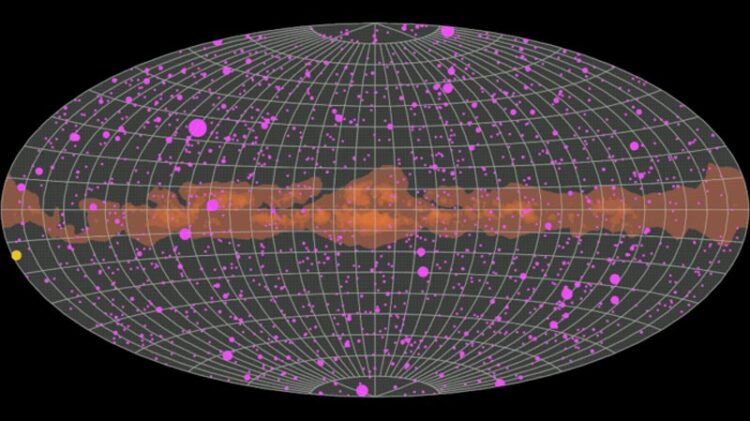NASA’s Fermi captures dynamic gamma-ray sky in new animation

Watch a cosmic gamma-ray fireworks show in this animation using just a year of data from the Large Area Telescope (LAT) aboard NASA’s Fermi Gamma-ray Space Telescope. Each object’s magenta circle grows as it brightens and shrinks as it dims. The yellow circle represents the Sun following its apparent annual path across the sky. The animation shows a subset of the LAT gamma-ray records now available for more than 1,500 objects in a new, continually updated repository. Over 90% of these sources are a type of galaxy called a blazar, powered by the activity of a supermassive black hole.
Credit: NASA's Marshall Space Flight Center/Daniel Kocevski
Cosmic fireworks, invisible to our eyes, fill the night sky. We can get a glimpse of this elusive light show thanks to the Large Area Telescope (LAT) aboard NASA’s Fermi Gamma-ray Space Telescope, which observes the sky in gamma rays, the highest-energy form of light.
This animation shows the gamma-ray sky’s frenzied activity during a year of observations from February 2022 to February 2023. The pulsing circles represent just a subset of more than 1,500 light curves – records of how sources change in brightness over time – collected by the LAT over nearly 15 years in space.
Thanks to the work of an international team of astronomers, this data is now publicly available in a continually updated interactive library. A paper about the repository was published March 15, 2023, in The Astrophysical Journal Supplement Series.
“We were inspired to put this database together by astronomers who study galaxies and wanted to compare visible and gamma-ray light curves over long time scales,” said Daniel Kocevski, a repository co-author and an astrophysicist at NASA’s Marshall Space Flight Center in Huntsville, Alabama. “We were getting requests to process one object at a time. Now the scientific community has access to all the analyzed data for the whole catalog.”
Over 90% of the sources in the dataset are blazars, central regions of galaxies hosting active supermassive black holes that produce powerful particle jets pointed almost directly at Earth. Ground-based observatories, like the National Science Foundation’s IceCube Neutrino Observatory in Antarctica, can sometimes detect high-energy particles produced in these jets. Blazars are important sources for multimessenger astronomy, where scientists use combinations of light, particles, and space-time ripples to study the cosmos.
“In 2018, astronomers announced a candidate joint detection of gamma rays and a high-energy particle called a neutrino from a blazar for the first time, thanks to Fermi LAT and IceCube,” said co-author Michela Negro, an astrophysicist at the University of Maryland, Baltimore County, and NASA’s Goddard Space Flight Center in Greenbelt, Maryland. “Having the historical light curve database could lead to new multimessenger insights into past events.”
In the animation, each frame represents three days of observations. Each object’s magenta circle grows as it brightens and shrinks as it dims. Some objects fluctuate throughout the entire year. The reddish orange band running across the middle of the sky is the central plane of our Milky Way galaxy, a consistent gamma-ray producer. Lighter colors there indicate a brighter glow. The yellow circle shows the Sun’s apparent annual trajectory across the sky.
Processing the full catalog required about three months, or more than 400 computer years of processing time distributed over 1,000 nodes on a computer cluster located at the SLAC National Accelerator Laboratory in Menlo Park, California.
The LAT, Fermi’s primary instrument, scans the entire sky every three hours. It detects gamma rays with energies ranging from 20 million to over 300 billion electron volts. For comparison, the energy of visible light mostly falls between 2 to 3 electron volts.
The Fermi Gamma-ray Space Telescope is an astrophysics and particle physics partnership managed by Goddard. Fermi was developed in collaboration with the U.S. Department of Energy, with important contributions from academic institutions and partners in France, Germany, Italy, Japan, Sweden, and the United States.
Journal: The Astrophysical Journal
DOI: 10.3847/1538-4365/acbb6a
Article Title: The Fermi-LAT Lightcurve Repository
Article Publication Date: 15-Mar-2023
Media Contact
Claire Andreoli
NASA/Goddard Space Flight Center
claire.andreoli@nasa.gov
All latest news from the category: Physics and Astronomy
This area deals with the fundamental laws and building blocks of nature and how they interact, the properties and the behavior of matter, and research into space and time and their structures.
innovations-report provides in-depth reports and articles on subjects such as astrophysics, laser technologies, nuclear, quantum, particle and solid-state physics, nanotechnologies, planetary research and findings (Mars, Venus) and developments related to the Hubble Telescope.
Newest articles

First-of-its-kind study uses remote sensing to monitor plastic debris in rivers and lakes
Remote sensing creates a cost-effective solution to monitoring plastic pollution. A first-of-its-kind study from researchers at the University of Minnesota Twin Cities shows how remote sensing can help monitor and…

Laser-based artificial neuron mimics nerve cell functions at lightning speed
With a processing speed a billion times faster than nature, chip-based laser neuron could help advance AI tasks such as pattern recognition and sequence prediction. Researchers have developed a laser-based…

Optimising the processing of plastic waste
Just one look in the yellow bin reveals a colourful jumble of different types of plastic. However, the purer and more uniform plastic waste is, the easier it is to…


